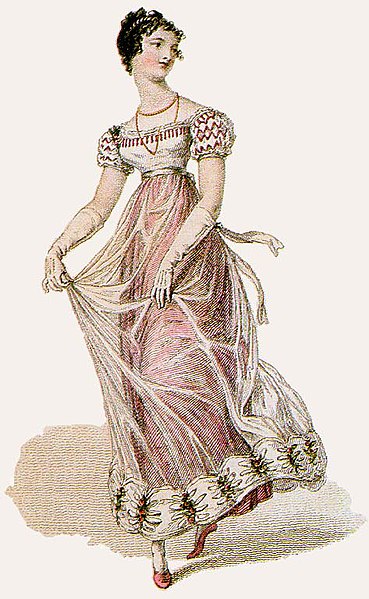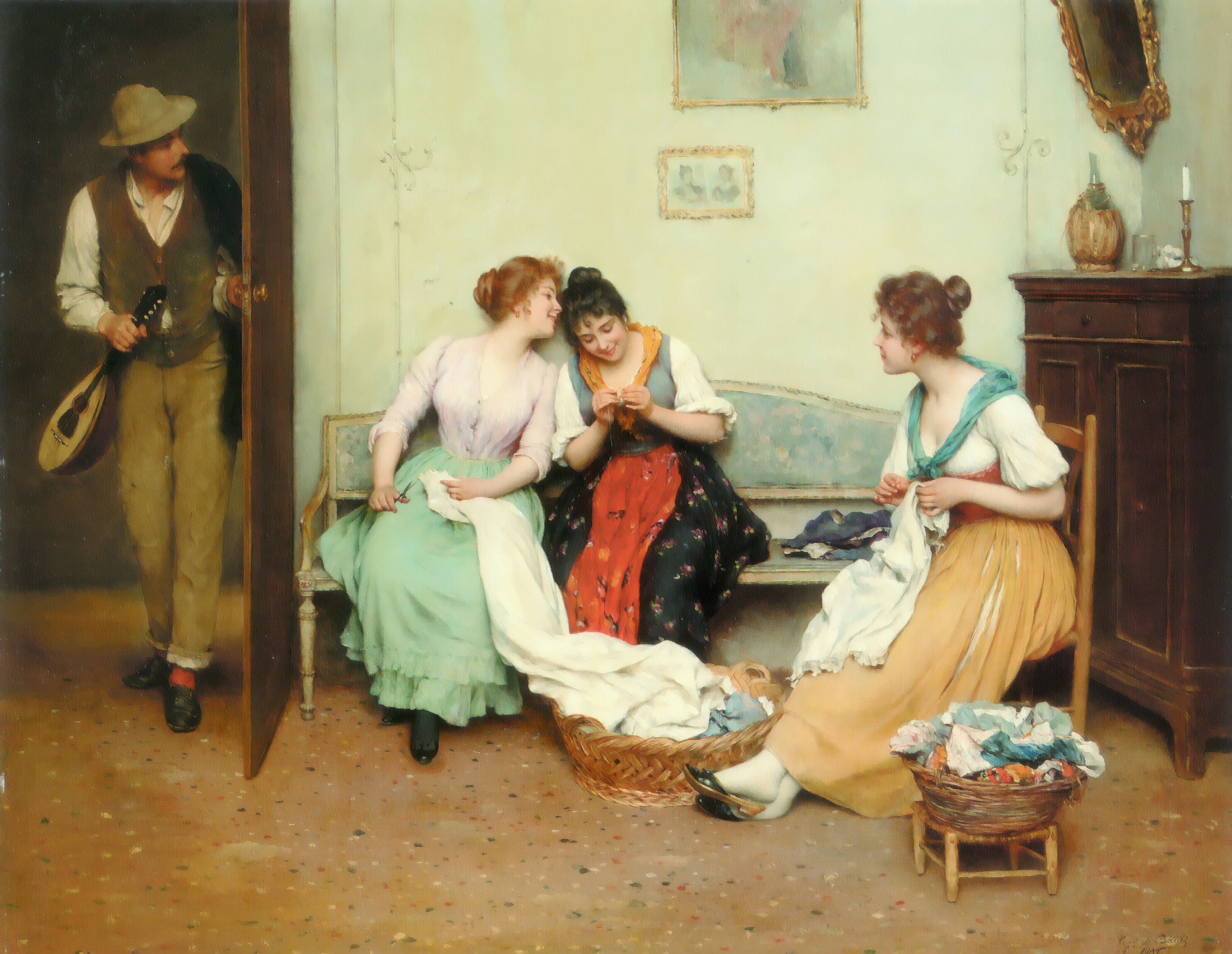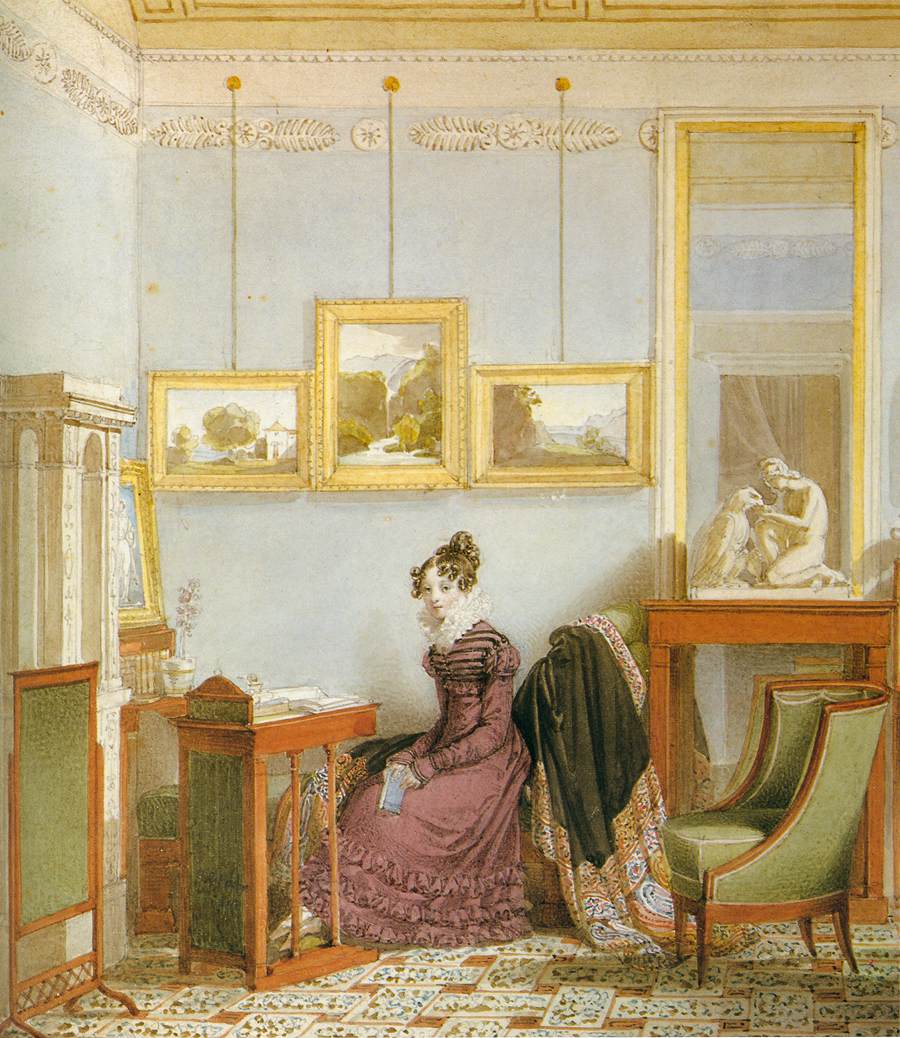by Maria Grace
 During the Regency era, a proper education was crucial to a middle or upper class young lady’s future. Since a woman’s only ‘proper’ aspiration was to marriage, her education focused on making her noticeable to potential husbands. Her accomplishments enabled her to display cultural distinction and set herself apart from women who were merely ‘notable’—those who could only manage a household but not cultivate elegant socializing.
During the Regency era, a proper education was crucial to a middle or upper class young lady’s future. Since a woman’s only ‘proper’ aspiration was to marriage, her education focused on making her noticeable to potential husbands. Her accomplishments enabled her to display cultural distinction and set herself apart from women who were merely ‘notable’—those who could only manage a household but not cultivate elegant socializing.
The number of accomplishments a young lady acquired reflected the financial state of her family and the level of sacrifice they were willing to make to improve her chances of marrying well.
Men of the middle and upper classes sought a wife who would be a social asset to them (in addition to a good dowry of course.) A "social asset" was to never be an intellectual threat to her husband, but to able to follow conversation, and perhaps more importantly to keep a conversation away from unpleasantries and steered toward good humor for all. She could understand what was being said around her, but did not have ready opinions or advice to offer.
Certain subjects were considered necessary for becoming that desired social asset.
 No young woman could be considered accomplished without the ability to read. Not only was it necessary for basic household management and correspondence, but it formed a foundation for intelligent conversation and for reading aloud for the entertainment of others.
No young woman could be considered accomplished without the ability to read. Not only was it necessary for basic household management and correspondence, but it formed a foundation for intelligent conversation and for reading aloud for the entertainment of others.
Though young ladies were not encouraged to read heavy subjects like philosophy and theology, serious books were considered appropriate as they enabled interesting conversation. Similarly, scripture to enable her to recognize passages and sermons, such as Fordyce’s, aimed at young women, were appropriate reading for an accomplished lady.
In this context, writing did not refer to a creative endeavour, but rather being able to create a letter with beautiful penmanship, correctly spelled and with excellent grammar. Young women would be schooled in the art of letter writing, with books dedicated to the topic and offering examples of good letters for her to emulate. She might even copy particularly pretty phrases out of these books for use in her own letters.
 During the Regency era, a proper education was crucial to a middle or upper class young lady’s future. Since a woman’s only ‘proper’ aspiration was to marriage, her education focused on making her noticeable to potential husbands. Her accomplishments enabled her to display cultural distinction and set herself apart from women who were merely ‘notable’—those who could only manage a household but not cultivate elegant socializing.
During the Regency era, a proper education was crucial to a middle or upper class young lady’s future. Since a woman’s only ‘proper’ aspiration was to marriage, her education focused on making her noticeable to potential husbands. Her accomplishments enabled her to display cultural distinction and set herself apart from women who were merely ‘notable’—those who could only manage a household but not cultivate elegant socializing.The number of accomplishments a young lady acquired reflected the financial state of her family and the level of sacrifice they were willing to make to improve her chances of marrying well.
Men of the middle and upper classes sought a wife who would be a social asset to them (in addition to a good dowry of course.) A "social asset" was to never be an intellectual threat to her husband, but to able to follow conversation, and perhaps more importantly to keep a conversation away from unpleasantries and steered toward good humor for all. She could understand what was being said around her, but did not have ready opinions or advice to offer.
Certain subjects were considered necessary for becoming that desired social asset.
Reading
 No young woman could be considered accomplished without the ability to read. Not only was it necessary for basic household management and correspondence, but it formed a foundation for intelligent conversation and for reading aloud for the entertainment of others.
No young woman could be considered accomplished without the ability to read. Not only was it necessary for basic household management and correspondence, but it formed a foundation for intelligent conversation and for reading aloud for the entertainment of others.Though young ladies were not encouraged to read heavy subjects like philosophy and theology, serious books were considered appropriate as they enabled interesting conversation. Similarly, scripture to enable her to recognize passages and sermons, such as Fordyce’s, aimed at young women, were appropriate reading for an accomplished lady.
Writing
In this context, writing did not refer to a creative endeavour, but rather being able to create a letter with beautiful penmanship, correctly spelled and with excellent grammar. Young women would be schooled in the art of letter writing, with books dedicated to the topic and offering examples of good letters for her to emulate. She might even copy particularly pretty phrases out of these books for use in her own letters.
Arithmetic
No mistress could run a household or estate without a solid understanding of basic math. She had to be able to keep accounts, balance a budget, calculate how much food and others supplies needed to be bought, track expenses and even forecast trends in the use of supplies.
Few women would have exposure to advanced algebra or other pure mathematics. She had no practical use for them and would be dangerously close to challenging her husband’s expertise if she knew them.
Few women would have exposure to advanced algebra or other pure mathematics. She had no practical use for them and would be dangerously close to challenging her husband’s expertise if she knew them.
Sciences and Social sciences
The natural sciences and social sciences were significant to young ladies only insofar as they facilitated the art of refined conversation. General awareness and rote memorization in areas of history, politics, geography, literature and philosophy were sufficient for ladies of quality.
A cursory knowledge of botany was common. Ladies who were more interested might also become learned in the use of plants as home remedies since the mistress of an estate was often the first one consulted in cases of injury and illness.
Languages
Despite the Napoleonic wars, a working knowledge of French was indispensable for a young lady. Italian and German, for singing and understanding sung performances were also useful, but conversational fluency was not expected. Greek and Latin, beyond a handful of commonly used phrases were the purview of men and not included in a young lady’s curriculum.

Music
Though not expected to be virtuosos, quality young ladies were expected to be proficient musicians. Playing and singing were considered seductive to men since they displayed her body and bearing to potential suitors. Furthermore, once married, musical skills would be useful for long evening of entertaining both her husband and her guests.
Only a few instruments were considered appropriate for young ladies. Anything which needed to be blown into was a risk for causing a reddened face and heaving bosom, neither of which would be attractive, much less alluring, so they were out of the question. The violin, which required raised arms, was also inappropriate. The short bodied dresses of the era presented too many possibilities for embarrassing mishaps. Moreover, the violin required a higher level of expertise to perform and the potential for embarrassing oneself with a mediocre was greater.
The harp was the most desirable instrument, but most had to make do with the piano which had replaced the harpsichord in popularity. Some young ladies also learned the guitar.
Not only did girls need to be able to play and sing, but they had to be able to dance. The dance floor was the place for young ladies to interact with their suitors, a place where they could escape the watchful eyes of their chaperones and engage in somewhat private conversation and even touch, which was otherwise entirely forbidden. Skilled and graceful partners were highly desirable. Girls who danced poorly could expect to spend a lot of time without a partner.
Artistic endeavors
Girls were encouraged to draw and paint and given training in it whenever possible. Particularly talented girls might even exhibit their work at local or national levels, or teach other girls, all of which could be valuable if she failed to obtain a husband.
Filigree work, now known as quilling, and japanning, now called decoupage, were also encouraged as ways for ladies to display their artistic skills. Screens, small
chests and trunks and various bric-a-brac were frequently the object of their efforts.
Needlework (plain and fancy)
 Needlework was one of the most practical subjects for a young lady. No matter what her future might hold, clothing, plain or elegant, would be a part of it. Clothing required mending and making. Even ladies who could hire out their own sewing would often engage in making garments for charitable cases in their parish. Fancy work included embroidery, cross stitch, knotting, netting and more.
Needlework was one of the most practical subjects for a young lady. No matter what her future might hold, clothing, plain or elegant, would be a part of it. Clothing required mending and making. Even ladies who could hire out their own sewing would often engage in making garments for charitable cases in their parish. Fancy work included embroidery, cross stitch, knotting, netting and more.Needlework need not be a solitary endeavor. Often, women would bring along their work baskets during social calls and work as they visited. If someone arrived without something to work on, a hostess might offer something from her workbasket to her visitor. Of course, the elegance of the project would reflect upon the seamstress and fancy projects were more desirable for working in company than plain.
Boarding Schools
Girl’s education was a bit of a controversial subject. Girls from wealthy and cultured homes were often educated by their mothers since they could hire enough help with the household work to have time to invest in their daughter’s education. They might enlist the aid of additional teaching masters for training in music, languages and dance. Alternatively, at the age of ten, parents might consider sending their daughter to a boarding school, sometimes for as little as a year or two to ‘finish’ their accomplishments. If the girls was in the way at home, she might be sent off for much longer.
_after_Horemans.jpg) Boarding school could be a risky proposition. Many girls' school were underfunded, badly managed, and were never quite respectable. Teachers frequently came from the ranks of clever, but poor former students, impoverished gentlewomen, poor relatives of the clergy or retired servants of the upper classes.
Boarding school could be a risky proposition. Many girls' school were underfunded, badly managed, and were never quite respectable. Teachers frequently came from the ranks of clever, but poor former students, impoverished gentlewomen, poor relatives of the clergy or retired servants of the upper classes.Subjects taught at these schools included decidedly nonacademic subjects like sewing and fancy needlework, drawing, dancing, music. Polite literature, including mythology, writing, arithmetic, botany, history, geography, and French formed the balance of the more academic studies. Rudiments of stagecraft and acting might also be taught as training in elocution and grace of movement.
Parents typically paid twenty to thirty guineas per year for these schools. Some of these subjects, particularly those which required additional masters to be brought in, like dance, might incur additional fees. Washing and the privilege of being a ‘parlor boarder’ who enjoyed extra privileges like eating with the mistress of the school and using the parlor, also incurred additional fees.
Armed with these skills, a young woman would be considered ready to enter society and engage in the all-important task of finding a suitable husband.
References
Baird, Rosemary. Mistress of the House, Great Ladies and Grand Houses. Phoenix (2003)
Collins, Irene. Jane Austen, The Parson's Daughter; Hambledon (1998)
Collins, Irene. Jane Austen & the Clergy; The Hambledon Press (2002)
Davidoff, Leonore & Hall, Catherine. Family Fortunes: Men and Women of the English Middle Class 1780-1850; Routledge (2002)
The Female Preceptor. Essays On The Duties Of The Female Sex, Conducted By A Lady. 1813 and 1814
Fullerton, Susannah. Jane Austen & Crime; JASA Press (2004)
Harvey, A. D. Sex in Georgian England; Phoenix Press (1994)
Ives, Susanna Educating Your Daughters – A Guide to English Boarding Schools in 1814, March, 10 2013.
Jones, Hazel. Jane Austen & Marriage; Continuum Books (2009)
Lane, Maggie. Jane Austen's World; Carlton Books (2005)
Laudermilk, Sharon & Hamlin, Teresa L. The Regency Companion; Garland Publishing (1989)
Le Faye, Deirdre. Jane Austen: The World of Her Novels; Harry N. Abrams (2002)
Martin, Joanna. Wives and Daughters; Hambledon Continuum (2004
Selwyn, David. Jane Austen & Leisure; The Hambledon Press (1999)
Sullivan, Margaret C. The Jane Austen; Handbook Quirk Books (2007)
Watkins, Susan. Jane Austen's Town and Country Style; Rizzoli (1990)
This article is an Editor's Choice and was originally published June 10, 2014.
~~~~~~~~~~~~
Though Maria Grace has been writing fiction since she was ten years old, those early efforts happily reside in a file drawer and are unlikely to see the light of day again, for which many are grateful.
After penning five file-drawer novels in high school, she took a break from writing to pursue college and earn her doctorate. After 16 years of university teaching, she returned to her first love, fiction writing.
Click here to find her books on Amazon. For more on her writing and other Random Bits of Fascination, visit her website. You can also like her on Facebook, or follow on Twitter.



I was curious to know if these expectations of a proper lady were the same a century earlier in England (early to mid 18th century)? Or if it was only reserved for the nobility at the time?
ReplyDeleteLovely post Maria~
ReplyDeleteHi, Maria. Thanks for the great post! I'm going to post it on FB and share it with the Beau Monde chapter of RWA. A nice summary of what every young woman was expected to have.
ReplyDeleteLoved this post! Do you have any idea what this meant to Georgiana Darcy? According to Wickham (so perhaps taken with a grain of salt) her home was in London since her father's death, when she was about 12 years old. Later we learn she was taken from school the summer Ramsgate happened. Do you think she was in school those three years? Or did she live in London with a governess before going to school? Or perhaps did not live in London at all until she went to school and perhaps only for one year?
ReplyDelete